AMD’s Radeon HD 5850: The Other Shoe Drops
by Ryan Smith on September 30, 2009 12:00 AM EST- Posted in
- GPUs
Power, Temperature, & Noise
With Cypress pared down some for the 5850, the power/temperature/noise situation takes on a different look. The 5870 ended up being hot, noisy, and more power-hungry than any other single-GPU setup under load. Let’s see if the 5850 can avoid that.
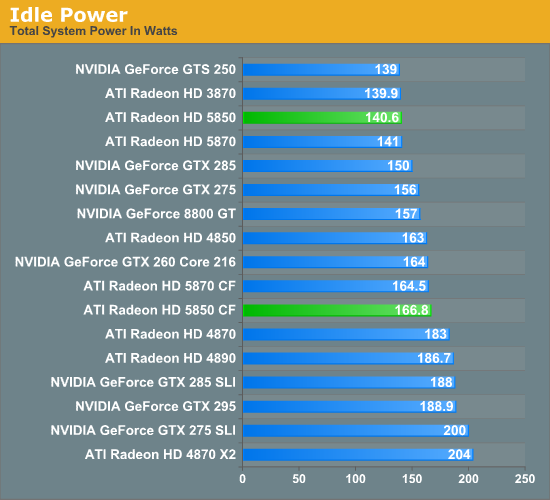
Looking at idle power, the results are the same as the 5870. This is to be expected as both are capable of reaching the same low idle power state. Crossfire results are similar, although the 5850 CF nudges itself higher than the 5870 CF on our charts; but this is within experimental variance.
As was the case with the 5870, the 5850 is among the lowest idling cards we have seen. It’s at the very bottom, only the Radeon HD 3870 and the GeForce GTS 250 can beat it, and even then just by a watt and a half.
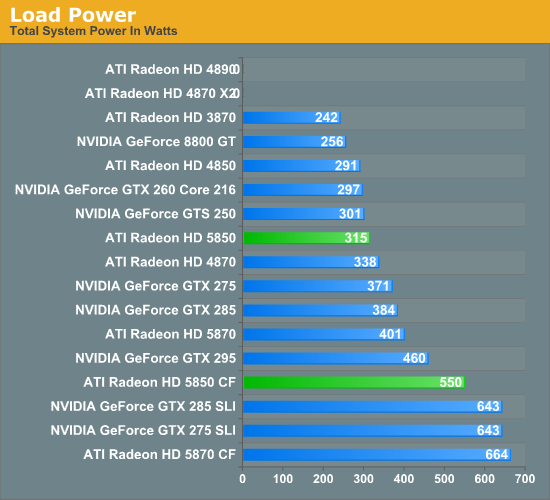
Load power on the other hand gives us a surprising difference. While the 5870 was one of the most power-hungry single-GPU cards we tested, the 5850 moves half-way down the chart. At load it uses less power than 4870 and most of the GTX series, in effect using less power than all of its closest performance competitors. In fact the difference in load power is beyond the specs; AMD’s specs call for a 37W difference, but here we have an 86W difference. Even after accounting for power supply inefficiencies, this is still a huge difference. We’re not seeing clock throttling occurring, so at this point we don’t have a complete explanation for what we’re seeing beyond the fact that we’re sure these are legitimate results.
The end result is that it’s clear that the 5850 is going to work well in systems with limited power abilities. At the same power envelope it’s significantly faster than anything else, and at the same performance level it’s significantly less power hungry than anything else.
As for Crossfire, this gap closes somewhat in that configuration. Here it’s only 114W under the 5870 CF, and just 93W under the GTX SLI cards. Even with its low power usage, the 5850 can’t erase the fact that multi-card solutions eat much more power than single-card solutions; it’s 90W over the GTX295, for example.
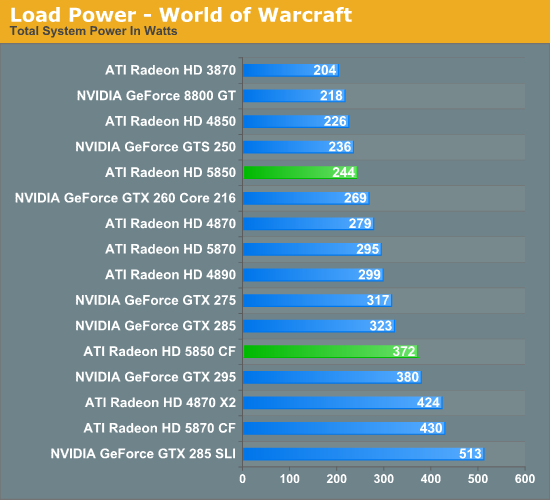
We’ll also take a look at power usage in Warcraft quickly, since it doesn’t trigger throttling in our other AMD cards. Warcraft doesn’t push these cards like OCCT does, so the overall power usage is lower, but the overall situation is virtually the same. The 5850 comes in at 55W less than the 5870, and this time bests the entire GTX lineup by at least 25W. We also see Crossfire do better here; now the 5850 CF can beat even multi-GPU cards like the 4870X2 and the GTX 295.
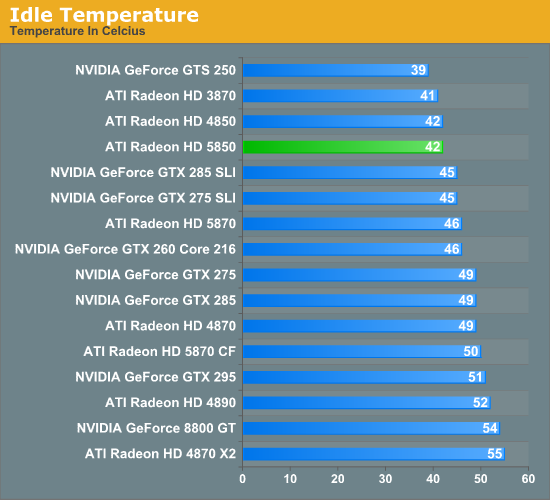
Interestingly enough, in spite of the same idle power as the 5870, the idle temps are not the same. The 5850 comes in at a chilly 42C, bringing it in line with the 4850 and the 3870. Only the GTS 250 can beat it by 3C, and in turn the 5850 beats its closest competitors, the GTX series, by at least 3C.
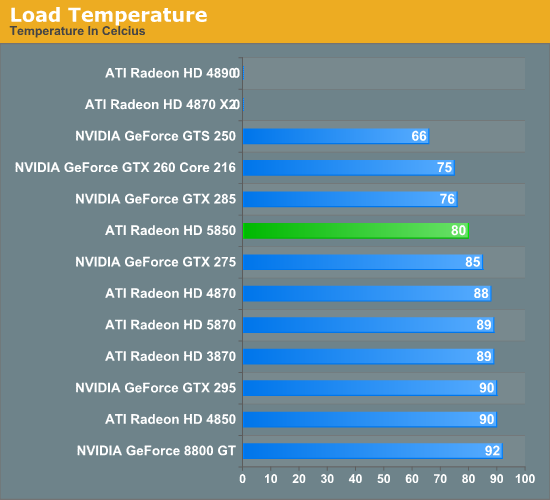
With lower power usage and a similar cooler, the 5850 is capable of keeping cooler than the 5870. While the 5870 approached 90C, the 5850 we’re testing was able to stay at 80C. This makes it the only AMD card we’ve tested that isn’t approaching 90C, which is good news for those of you with limited case ventilation. However it still loses to the GTS 250, and most of the GTX cards. We know NVIDIA is consuming more power, so clearly they have a more effective cooler in use if it’s able to cool their cards that well.
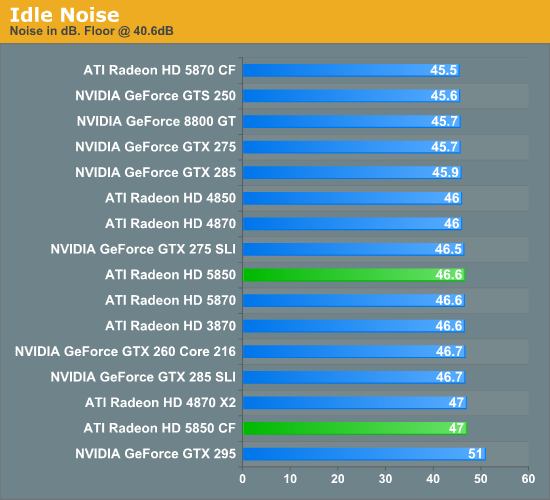
Finally we have noise. At idle virtually everything is the same, the 5850 and the 5870 come in at 46.6dB. To see a significant difference here, we would have to switch to a passively-cooled card.
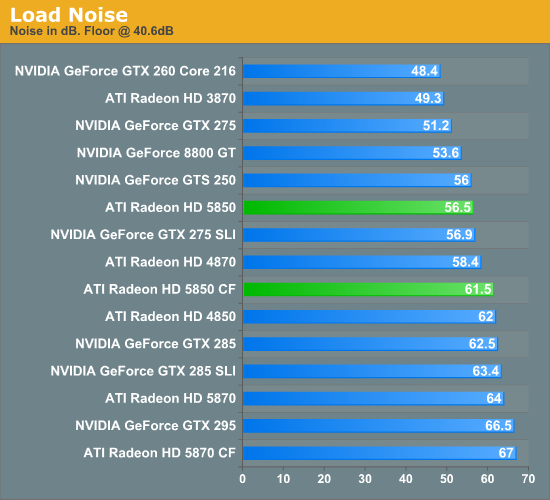
At load, the 5850 is just below the middle of the pack. Thankfully it’s not nearly as loud as the 5870, shaving off 8dB compared to its big brother and brings a Cypress-based card in to more reasonable territory. Adding a second card for Crossfire makes things louder at 61dB, but even that is still 6dB quieter than the 5870 CF.
This also shows us the tradeoffs NVIDIA made in cooling compared to AMD. The GTX 285, which was cooler running, is 6dB louder here as a result. Going by our charts the 5850 is fairly balanced in noise and temperature; it’s doesn’t need to make any trade-offs to achieve one or the other.










95 Comments
View All Comments
ThePooBurner - Wednesday, October 7, 2009 - link
A good repeatable test would be to have a RAID group in an instance and have them all cast a set of spells at once. the instance server separates from the rest of the server load and allows for a bit better testing. While it's true that the game is generally more CPU/RAM limited than GPU limited, especially if you have a lot of add-ons doing post processing on all the information that is shooting around. However, having been in raids with and without add-ons and such, i can tell you that i can get 45-50fps when we are just standing there waiting to attack, and then as soon as the spell effects start going off my frame rate drops like a rock. The spell effects are particle effects that overlap and mix and are all transparent to one degree or another. All those effects going off on a single target creates a lot of overlap that the GPU has to sort out in order to render correctly.What you might try is to see if you can get Blizz to put a target dummy in an instance to isolate it from the rest of the masses, and allow for sustained testing with spell effects going off in a predictable manner. (not having every testing go balls to the wall, but simply repeat a set rotation in a timed manner so that you can get an accurate gauge.
Per Hansson - Thursday, October 1, 2009 - link
I second your questionAnd also just want to say that with a very heavily volt modded and overclocked 8800GTS 512MB the performance in WoW at maximum settings with 2xAA will totally kill my card
For example in heavily populated areas it will use more than 512MB video ram (confirmed using rivatuner)
And in heavily populated areas I get like 20FPS, for example in Dalaran at peak hours (like, when I play :P)
The numbers you provide for WoW are welcome, very few sites do these tests
But more realistic numbers would be nice, representing what a big guild would see in a 20 or 40 man RAID...
Perhaps you could setup a more realistic test with private servers, or if you are unwilling to go that route ask Blizzard if they could setup a testserver for you to use so you can get reproducible tests?
biigfoot - Wednesday, September 30, 2009 - link
I can't wait till we find out if those extra SIMD engines can be unlocked like the good ol' ati2mtag softmod for the 9500 -> 9700 :) Even if not, this looks like the card for my new HTPC :)The0ne - Wednesday, September 30, 2009 - link
The charts are a bit confusing. My main focus is at the 2560x1600 and the review references 5850 CF and 285 CF but they are not to be found in any of the charts. Same for 285 SLI"With and without ambient occlusion, the 5850 comes in right where we expect it. The 5850 Crossfire on the other hand loses once again to the GTX 285 SLI in spite of beating the GTX 285 in a single card matchup."
Ryan Smith - Wednesday, September 30, 2009 - link
Whoops. The full 2560 w/o SSAO chart went AWOL. Fixed.giantpandaman2 - Wednesday, September 30, 2009 - link
Should be heels, not heals. Unless you're referring to some MMORPG priest. :)KeithP - Wednesday, September 30, 2009 - link
I understand you want a consistent platform to test all the video cards, but is there any possibility of testing the 5850 on a more realistic platform?Maybe something like a dual core 2.8GHz machine? I have to think the bulk of the potential buyers for this card won't have a machine anywhere near as powerful as the one you are testing on.
-KeithP
v1001 - Wednesday, September 30, 2009 - link
I wonder if we'll see a single slot card. I think this is the card for me to get. I need a lower watt single slot card to work in my tiny case.RDaneel - Wednesday, September 30, 2009 - link
Ryan, I know it's not the focus of this article, but it would be great to get a small paragraph (or a blog post or whatever) on what ATI has said in reference to the lower-spec 40nm DX11 parts. I simply don't need 4850 power in a SOHO-box, but the low 40nm idle power consumption and DX11 future-proofing are tempting me away from a 4870/90 card. What kind of prices and performance scaling are we likely to see before the end of 2009? Thanks for any info!Ryan Smith - Wednesday, September 30, 2009 - link
We covered this as much as we can in our 5870 article. If it's not there, it's either not something we know, or not something we can comment on.http://www.anandtech.com/video/showdoc.aspx?i=3643...">http://www.anandtech.com/video/showdoc.aspx?i=3643...